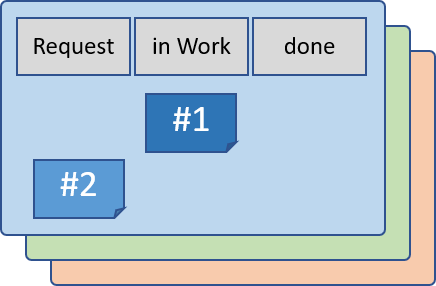In organization theory, a distinction is made between the organizational structure and the process organization. In classical organizations the department structure corresponds to the organizational line structure, whereby these form usually functional units and summarize thus specialized coworkers (e.g. sales, production)*. The classical expiration organization is regulated thereby either over work processes, which regulate the responsibilities of the departments and the handing over between the departments.
A second more and more frequently used classical process organization is the project with its own organizational structure. This creates the so-called matrix organization of project and department. The ever-increasing use of projects and the resulting assignment of employees to several projects creates increasingly complex and small-scale work structures. This is described in detail in our article “The monopoly of projects“.
Ways to less complexity and more agility
Now there are various approaches to transforming the classic structure of the process organization through lean and agile approaches.
Scrum within projects, but …
One approach is to use Scrum for project management. This works quite well for projects that run over a period of at least three months, or even shorter periods if the team members are well-coordinated and experienced with Scrum. A second even more important factor is that the team members work at least 50% (and all at the same time) for the project; 100% is to be aimed for. If this is not given, the approach “Scrum in the project” does not work. Imagine employees working in three to five Scrum projects at the same time. More about this in the article “If it has to be an agile project …“.
Extensive avoidance of separation of organizational line structure and process organization
To reduce complexity in the organizational structure, the following agile and lean approaches do without the separation of organizational structure and process organization! This has several advantages.
- Each employee has only one boss, who sets work priorities
- Long-lived teams lead to closer human relationships (see also …)
- Employees of a team sit and also work together
- Team members learn from each other
Kanban for the management of workflows in functionally structured organizations
The functional organizational structure already mentioned above with the control by work processes can be well represented by Kanban boards. Here, we usually assume a linear process. However, this only works with a low degree of complexity, since interdisciplinary or cross-functional work only takes place on an ad-hoc basis or via meetings.

The Lean/Kanban approach makes the amount of work visible across all departments in the first step and uses a Kanban board for this purpose. This must be globaly available and transparent.

Advantages
- For the introduction of Kanban, the departments do not have to be restructured and both the employees and the managers can remain in their departments. Thus a substantial entrance hurdle is bypassed.
- Employees with the same knowledge work together and can thus support and train each other. This allows each department to work at maximum efficiency and utilization. However, since employees often work for different projects, they still have little to do with each other.
Disadvantages
- It is of little use to organize only one or a few departments with Kanban, because only the view of the entire workflow shows the bottlenecks and queues. Despite good successes with Kanban in one department, the overall success depends on improving the workflow across all departments.
- Due to the high degree of specialization, a work process passes through many departments with a correspondingly high number of handovers.
- The utilization of the overall system is limited by the capacity at the bottleneck. The employees in the bottleneck department are overloaded and thus not very motivated. All other employees are rather underloaded and therefore have to look for work in order not to look lazy. This also hurts motivation.
The mentioned disadvantages unfortunately diminish the advantages of Kanban as an easy entry in functional silo departments. From a global perspective, the advantages are not visible and do not encourage more classical departments to participate the Kanban approach.
Another option is to form small interdisciplinary teams. An important driver in this direction is “customer proximity” in all respects, physical, organizational and personal.
Agile and self-organized approach of interdisciplinary teams
The idea here is that small interdisciplinary teams serve only a portion of the customers. Many organizations recognized this in the early 2000s and established local sales and marketing teams within their relevant regions.

Following from this, the boards of the interdisciplinary teams also become simpler. To identify the differnet areas of extertise, different colors or keywords can be used:

Prominent examples are:
- Zollner Elektronik AG, a large german based electronics supplier. Although having around 12,000 emplyees, Zollner is able to serve small and medium sized customers on “eye-level”, because each small interdisciplinary team only serves a few customers. The samll team can build personal relationships to their customers.
- dm Drogeriemarkt, a drugstore chain with more than 62,000 emplyees and about 3,700 stores in 13 countries. The success lies in the maxim “All Power to the stores”.
We can use the same approach within the product development organization:
- the customers are the requesting business units
- the customer orders are the development projects and
- the internal departments are the specialist departments within product development.
The approach has many advantages, but also poses a major challenge for teams that continue to operate globally, as they now have to deal with many internal “customers” who see only their local interests. This can be solved by consistent global prioritization.
The P4 framework supports the principle of local proximity and small interdisciplinary teams through its organizational structure, which is also used in product development. Here, products & applications can be developed per market segment in small interdisciplinary teams. The module & platform development can act centrally. The same applies to the customer-facing operation teams (see P4-Ops).
Footnotes
*) Classical organizational structures are unfortunately often influenced by the fact that departments are created for individual managers. Such managers often define their position and status in the organization by the number of subordinates.
Title photo from freepik.
